The IUGG Electronic Journal Volume 17 No. 1 (1 January 2017)
INTERNATIONAL UNION OF GEODESY AND GEOPHYSICS
UNION GEODESIQUE ET GEOPHYSIQUE INTERNATIONALE
The IUGG Electronic Journal
Volume 17 No. 1 (1 January 2017)
This informal newsletter is intended to keep IUGG Member National Committees informed about the activities of the IUGG Associations, and actions of the IUGG Secretariat. Past issues are posted on the IUGG website (http://www.iugg.org/publications/ejournals/). Please forward this message to those who will benefit from the information. Your comments are welcome.
Contents
1.Editorial: Highlights 2016
2.IUGG Strategic Plan 2016-2023
3.Union membership and financial situation
4.Logos of the IUGG Associations
5.IUGG’s centennial at UNESCO
6.Task Force on the IUGG 100th anniversary formed
7.Yearbook 2017
8.Report on the workshop of the IUGG Commission on Climatic and Environmental Change
9.Scientific Assemblies 2017
10.CTBT Science and Technology Conference 2017
11.Obituary – David Collins (1948-2016)
12.Meeting calendar
1.Editorial: Highlights 2016
The year 2016 was another remarkable year in the IUGG history. The first ever Strategic Plan of the Union was developed for 2016-2023 and adopted by the IUGG Council. The Union was involved in various activities during the last year and showed its strength in international cooperation and science promotion. Major activities and events are highlighted below.
- Association major activities. IUGG Associations were involved in the organization of their scientific assemblies to be held in 2017. Exciting scientific programs were developed for these events.
- Union Commission major events. Three Union Commissions, the Commission on Mathematical Geophysics (CMG), the Commission on the Study of the Earth’s Deep Interior (SEDI), and the Commission on Climatic and Environmental Change (CCEC), organized their scientific meetings: the Conference on Mathematical Geophysics was held in Paris, France; the SEDI symposium in Nantes, France; and the CCEC workshop in Belval, Luxembourg.
- Scientific meetings. IUGG co-sponsored 21 international workshops and symposia around the world.
- Research programs and projects. IUGG together with the International Union of Geological Sciences (IUGS) supported the International Lithosphere Programme (ILP). IUGG awarded grants to six interdisciplinary scientific projects within the framework of the IUGG Grants Programme.
- Publications. The Comptes Rendus of the 26th IUGG General Assembly in Prague, Czech Republic, was published1 by the IUGG Secretariat. The second volume of the IUGG Special Publications “Dynamics and Predictability of Large-Scale, High-Impact Weather and Climate Events” was published2.
- New Union committee. The ad-hoc Outreach committee was set up to organize and manage IUGG’s communication, promotion, public information and general outreach activities.
- IUGG Council. IUGG’s affairs are directed by the Union Council governed by the Statutes and By-Laws of the Union. Until 2015, the Union Council Delegates were appointed only for the duration of Council meetings held at IUGG General Assemblies and, therefore, major decisions could be taken only once every four years. To modernize the Union’s practices and to improve flexibility in decision-making, the IUGG Council at its meeting in Prague, Czech Republic, in June 2015 decided to extend the term of office of Council Delegates to four years (the time between two consecutive General Assemblies) and to introduce electronic voting.
- Science education. IUGG and the Abdus Salam International Centre for Theoretical Physics (ICTP) in Trieste, Italy, have continued their cooperation in geophysical and geodetic education and science collaboration. IUGG co-sponsored six geoscience education events in 2016.
- Science policy. (i) The IUGG/IAPSO together with the ICSU Scientific Committee on Oceanic Research (SCOR) developed a paper for science policymakers of seven economically developed countries on the topic of Future of the Ocean and its Seas. The paper was prepared towards the annual meeting of G7 Science Ministers (help in Tsukuba, Japan, in May 2016) as a response of non-governmental scientific organizations to the concern of the policymakers expressed at their meeting in Berlin, Germany, in September 2015. The paper is available at the ICSU website3. (ii) The IUGG Secretary General met the WMO Secretary General, the Assistant Director General of UNESCO, and the Senior Officer of the UN Office for Disaster Risk Reduction (UNISDR) to discuss joint efforts toward formation of an international panel for disaster risk assessment.
- Cooperation. IUGG continued to strengthen cooperation with scientific unions and interdisciplinary bodies of the ICSU such as the World Data System Committee and CODATA, as well as with the World Meteorological Organization (WMO), the United Nations Education, Science and Culture Organization (UNESCO), the Comprehensive Nuclear-Test-Ban Treaty Organization (CTBTO), the Group on Earth Observations (GEO), the World Climate Research Programme (WCRP), the Scientific Programme on Integrated Research on Disaster Risk (IRDR), Global Framework for Climate Services (GFCS), Future Earth and with some other international and intergovernmental organizations, professional societies of geoscientists, and international programs.
- Business meetings. The IUGG Bureau and Executive Committee met in Paris, France, in June and the meetings were hosted by the UNESCO Earth Science and Geohazards Risk Reduction Section. The IUGG President and Secretary General participated in the ICSU Unions Meeting in Paris and in the ICSU Extraordinary General Assembly in Oslo, Norway, to vote on a merger, in principal, of ICSU with the International Social Science Council (ISSC).
Alik Ismail-Zadeh, IUGG Secretary General
1 http://www.iugg.org/assemblies/2015prague
2 http://www.cambridge.org/9781107071421
3 http://www.icsu.org/news-centre/news/pdf/Report%20to%20G7%20SMins%20on%2...
The IUGG Executive Committee and the Secretariat thanks the Adhering Bodies and National Committees, Union Associations and Union Commissions as well as all individuals who helped make the year 2016 exciting and productive and who contributed to strengthening international scientific cooperation in Earth and space sciences for the benefit of society.
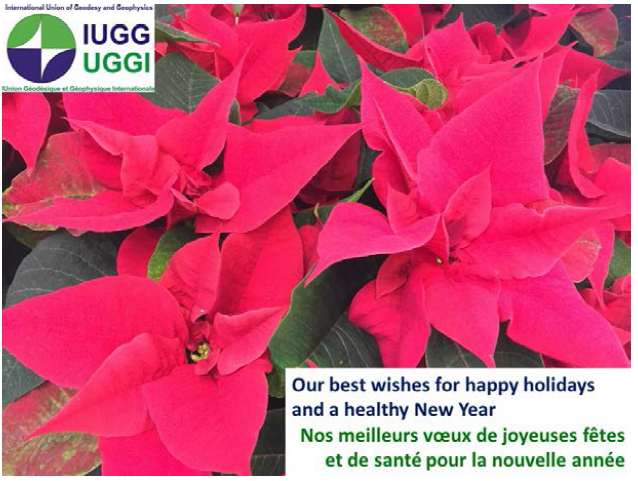
2.Strategic Plan 2016-2023
Strategic planning is an important visioning process to determine a strategy, mission, goals, and major activities of the organization for the near future. In 2014, the IUGG Visioning Committee was asked to draft a Strategic Plan of the Union for 2016-2023. The draft Strategic Plan was presented and discussed at the IUGG Council Meeting in Prague, Czech Republic, in 2015. The Council recommended revision of the plan based on the comments from Council Delegates. After receiving feedback from the Council Delegates, the Visioning Committee finalized the plan, which was endorsed by the IUGG Executive Committee. In December 2016, the IUGG Council approved unanimously the Strategic Plan: 30 (71.4%) of 42 eligible Council Delegates have voted in favor of the plan. The work of the Visioning Committee on the Strategic Plan is greatly acknowledged by the IUGG Executive Committee. The text of the Strategic Plan 2016-2023 can be found at: http://www.iugg.org/special/IUGG_StrategicPlan_2016-2023.pdf
3.Union membership and financial situation
As of 1 January 2017, IUGG has 69 National Members including 59 countries in paying status. The paying members are placed in categories from 1 to 14 depending on their financial contribution to the Union (the membership dues rise with increasing category number). At present the highest category used is category 11. The members pay dues according to a number of units assigned to their category (in category 1 the number of units is 1, and in category 11 the number is 35).
According to a decision of the XXII IUGG General Assembly (Boulder, USA, 1995), the price of 1 unit is determined every year using an inflator index obtained from the Bureau of Labor Statistics, U.S. Department of Labor. In 2017, the price of 1 unit will be US $1,935. The 59 paying members represent a total of 276 units, which is equivalent to a total income of US$ 534,060.
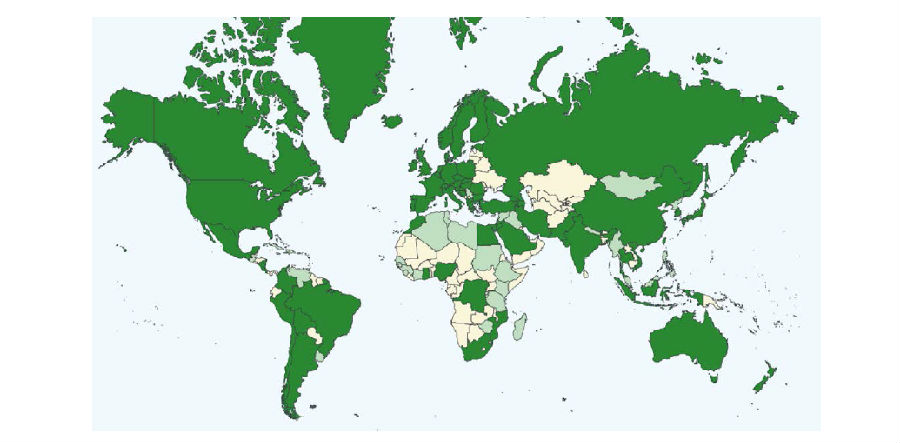
Regional distribution of current (dark green) and former (light green) IUGG Member Countries (as of 01.01.2017)
The funds received as dues are the basis for IUGG’s operations as a scientific union, although Union associations may have their own funds earned via book selling or donations. The funds are spent to support (i) international scientific programs, projects and services, (ii) general and scientific assemblies, symposia, workshops, and schools; (iii) travel of students, early career scientists, and scientists from developing countries to attend scientific meetings; (iv) scientific activities of Union Associations and Commissions, (v) the International Lithosphere Program, (vi) the International Council for Science, and (vii) administration and management.
Aksel Hansen, IUGG Treasurer
4. Logos of the IUGG Associations
The IUGG Executive Committee (EC), at its 2016 meeting in Paris, France, decided to design joint IUGG-Association logos. The IUGG Secretariat in a contact with a professional designer prepared a set of the logos, which was approved by the EC in December 2016. The new joint logos are presented below.
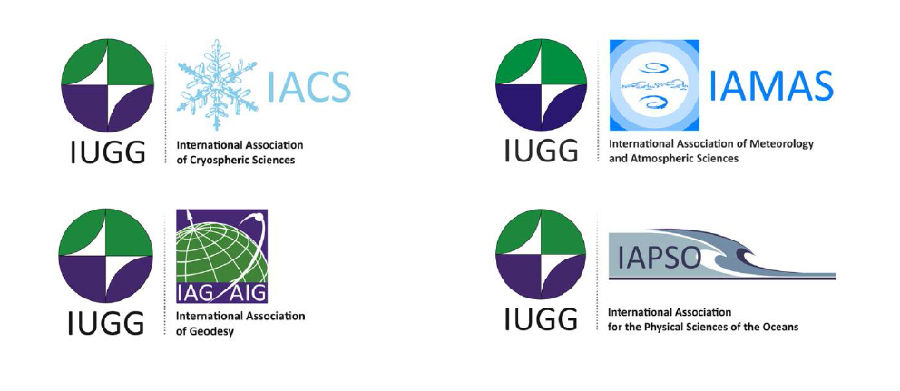
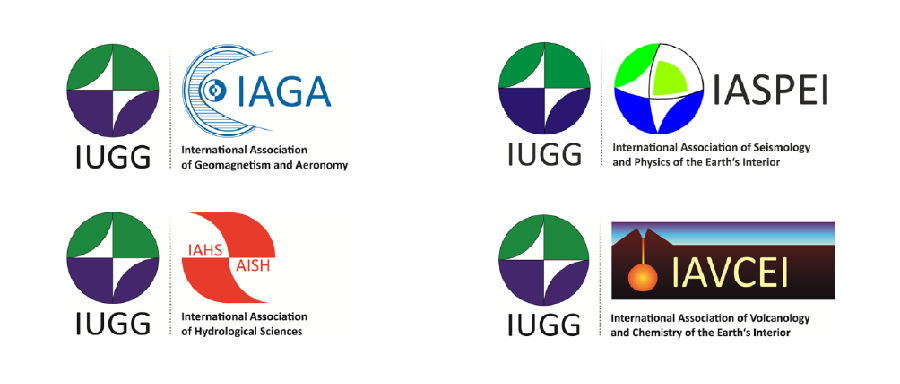
Joint IUGG-Association logos
5.IUGG’s 100th anniversary at UNESCO
In 2019, IUGG will celebrate its 100th anniversary. The Union was established by nine founding national members of the International Research Council in Brussels, Belgium, on 28 July 1919, and since that time more than 100 Member countries participated in Union’s activities. To celebrate the IUGG centennial as an international event of science, education and culture, together with IUGG international partners and friends around the world, IUGG requested permission of the United Nations Educational, Scientific and Cultural Organization (UNESCO) to hold an event at the UNESCO Headquarters in Paris, France.
Why at UNESCO? IUGG has developed a very fruitful cooperation with several UNESCO bodies, namely, with the Intergovernmental Oceanographic Commission (via IUGG/IAPSO and IUGG/Tsunami Commission), the International Hydrological Programme (via IUGG/IAHS, and IUGG/IACS), and the Earth Science and Geohazard Risk Section (via IUGG/IASPEI, IUGG/IAVCEI, and IUGG/GeoRisk Commission). IUGG will celebrate the Union’s achievements in promotion of Earth and space sciences and geoscience education for the last century especially those achieved in cooperation with UNESCO’s scientific programs. Recently, the UNESCO Assistant Director General for Natural Sciences informed the IUGG Secretary General that UNESCO agreed to host the event on Monday, 29 July 2019.
6.Task Force on the IUGG 100th Anniversary formed
To prepare the Union for its centennial, the IUGG President Michael Sideris appointed the following people to serve on the Task Force for the IUGG 100th Anniversary (TF100) to be celebrated in 2019:
− Chris Rizos, Chair of the Task Force, also Chair of the Visioning Committee
− Georges Balmino, former IUGG Secretary General;
− Athena Coustenis, Chair of the Honor and Recognition Committee;
− Johanna Salminen, Secretary General of the Finish National Committee for Geodesy and Geophysics, an early career scientist;
− Denise Smyth-Wright, President of IAPSO;− Hans Volkert, Chair of the IUGG working Group on History;
− Gordon Young, Chair of the Local Organizing Committee of the IUGG General Assembly in Montreal (Canada) in 2019;
− Michael Sideris, IUGG President (ex-officio);
− Alik Ismail-Zadeh, IUGG Secretary General (ex-officio); and
− Franz Kuglitsch, IUGG ASG/ES (IUGG Secretariat).
The TF100 will prepare a program for celebration of the event, including activities related to publications, science and education, science policy and outreach, and the legacy of the centennial.
7.Yearbook 2017
IUGG Yearbook 2017 is now electronically available in PDF format at the IUGG website (http://www.iugg.org/publications/yearbooks/yearbook2017.pdf). Thanks to the National Committees and the Associations for helping to update the information in the IUGG Yearbook! During 2017, updates on addresses and other information in the Yearbook should be sent to the IUGG Secretariat (secretariat@iugg.org) as soon as they are known. Our aim is to update the Yearbook as needed throughout the year. The Yearbook 2017 will be published together with the 2016 Annual Report and sent to National Members in May 2017.
8.Report on the workshop of the IUGG Commission on Climatic and Environmental Change
The second workshop of the IUGG Commission on Climatic and Environmental Change (CCEC) took place at the Université du Luxembourg in Belval, Luxembourg, from 21-22 October 2016. The workshop was conducted as a meeting of chapter authors of a forthcoming edited monograph “Global Change and Future Earth: The Geodetic and Geophysical Perspective” to be produced by the Cambridge University Press in October 2017. The monograph, which will be the third in the IUGG Series, seeks to deal with both aspects of the meaning of the term ‘future earth’. In title case, Future Earth refers to the recent international scientific research programme4 launched by the International Council for Science (ICSU), the International Social Science Council (ISSC), the Belmont Forum and a number of UN agencies. In lower case, it refers to the future of our planet, Earth.
The monograph thus seeks to expound how the geoscience community can assist Future Earth so as to improve the future of the Earth. It will comprise international and interdisciplinary contributions around the subject of climate change and its impacts on natural disasters and food security around the globe. The roles of the established scientific unions (e.g., IUGG) as well as new collaboration initiatives (e.g., Future Earth) in the advancement of multidisciplinary research will be highlighted throughout the monograph. Sixteen authors from Austria, Australia, Canada, China, Denmark, England, Germany, India, Japan, Luxembourg, New Zealand, Turkey, and USA presented, discussed, and finalized the content and structure of their chapters and the monograph’s eight key sections: 1) Future Earth and Planetary Issues, 2) Future Earth and Geodetic Issues, 3) Future Earth and the Earth’s Fluid Environment, 4) Future Earth and Regions, 5) Future Earth and Urban Environments, 6) Future Earth and Food Security, 7) Future Earth, Risk, Safety and Security, 8) Future Earth, Climate Change and Global Change.
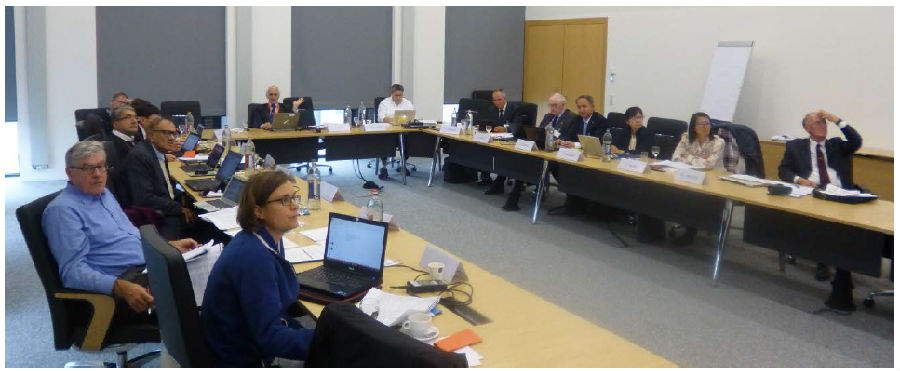
Opening Session (photo: Y. Kontar)
Fumiko Kasuga, Future Earth Global Hub Director, Japan, attended the meeting and gave an overview of Future Earth as an international global change research activity. Other contributions on the first day of the workshop included an overview of Climatic and Environmental Change by Tom Beer, CCEC Chair, as well as contributions from Alik Ismail-Zadeh, IUGG Secretary-General, and CCEC Members Eigil Friis-Christensen, Serhat Sensoy, Tonie Van Dam, Jianping Li and Harry Bryden (who presented jointly with Lawrence Mysak).
Contributions discussed during the second day of the workshop concentrated on the work of cognate scientific unions and included contributions from Ram Babu Singh (the International Geographical Union); Albert McGill (the International Union of Food Science and Technology), Ibrahim Elmadfa (the International Union of Nutritional Sciences), Jane Rovins (a former Executive Director of the Integrated Research on Disaster Risk (IRDR) Scientific Programme of ICSU, ISSC and UN Office for Disaster Risk Reduction), as well as those from Yekaterina Kontar (University of Alaska, USA) and Anke Schneider (GEOMAR, Germany). The meeting invited a social scientist Catherine Wong (University of Luxembourg), to provide a social science perspective on the proposed monograph, the work programme, the meeting, and the organization.
The workshop was facilitated by the local host, CCEC Member Tonie van Dam, Vice Rector of the University of Luxembourg, whose hard work and organizational capacities were greatly appreciated by all participants.
Submitted by T. Beer on behalf of the reporters: Y. Kontar, J. Li, and L. Mysak
9. Scientific Assemblies 2017
In 2017, the IUGG Associations will hold their Scientific Assemblies around the world. The figure below presents the dates and the places of the Scientific Assemblies. Scientists of all nations are invited to participate in the scientific events, to discuss their new findings, methodologies, and hypotheses, and to initiate, plan, and review collaborative research projects.
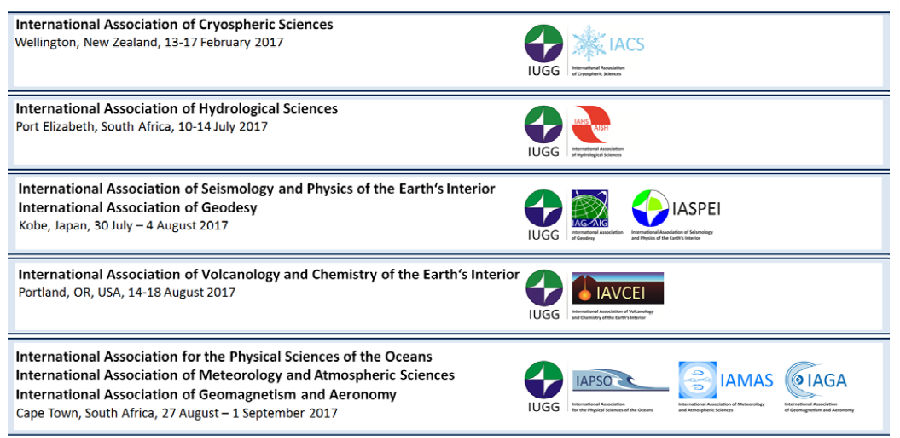
10. CTBT Science and Technology Conference 2017
The registration and abstract submission for the Science and Technology Conference (SnT2017) of the Preparatory Commission on Comprehensive Nuclear-Test-Ban Treaty (CTBT) organization to be held from 26 to 30 June 2017 at the Hofburg Palace in Vienna, Austria, is open at https://ctnw.ctbto.org/. Abstracts can be submitted for scientific oral or poster presentations. The deadline for abstract submission is Monday, 6 February 2017. The major goals of the SnT2017 are: (i) to enlarge the scientific community engaged in test-ban monitoring, including young scientists; (ii) to promote the wider scientific application of data that are used for test-ban verification; (iii) to enhance the exchange of knowledge and ideas between the CTBT organization and the broader scientific community; and (iv) to present to the scientific community the needs of nuclear test monitoring and verification. More information about the SnT2017 is available at https://www.ctbto.org/specials/snt2017/.
Submitted by W. R. Bell and N. M. Ozel, SnT2017 organizers
11. Obituary - David Collins (1948-2016)
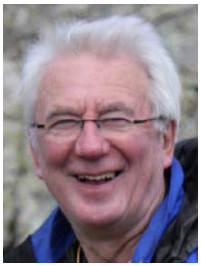
David Collins, Chair of the IUGG Finance Committee since 2011, a renowned glacier scientist and a pioneer in the field of glacier hydrology, has died at the age of 68. David was a larger-than-life figure in the sometimes staid world of academia, possessing an infectious and boundless energy and enthusiasm for science and adventure that was instrumental in inspiring generations of students to fulfil their potential and attain senior positions in academia, industry and commerce.
David began his formal academic career after graduating from Emmanuel College, University of Cambridge in 1974, commencing doctoral studies at the University of Nottingham and completing his thesis, entitled ‘Meltwater characteristics as indicators of the hydrology of Alpine glaciers’, in 1979 under the supervision of Dr Jean Grove. Following a brief period at the University of Liverpool in 1973, David took on the position of Lecturer at the University of Manchester in 1974, rising to the position of Reader by the early 1990s and being awarded the degree of Doctor of Science in 1997. After a brief spell at the University of Oxford as Dean of Keble College between 1996 and 1998, David returned to Manchester, taking up the position of Professor of Physical Geography at the University of Salford in 1999.
It was during his early years as an academic in the 1970s that David produced his most influential work. Focused upon the proglacial hydrology of Swiss alpine glaciers, David’s work utilising proglacial meltwater discharge, solute and sediment properties as tools to interpret and understand the hidden world of glacier drainage systems was pioneering and acted as a catalyst for the development of glacier hydrology as the distinctive sub-discipline we know today. To this day, David’s legacy is very much evident, as researchers continue to build upon his early, pioneering work, developing investigative and analytical methods that have clear lineage back to David. He believed passionately in field research, adventure and the collation of long-term data sets. To this end, he set up the ‘Alpine Glacier Project’ (AGP) while at the University of Manchester. The AGP was a long-term, monitoring project, predominantly based on proglacial hydrological monitoring, whereby students would travel to Switzerland each year to maintain instrumentation, collect data and learn field skills. Over its almost 40-year history, the AGP allowed hundreds of students to ‘cut their fieldwork teeth’ and, aside from the collection of some of the longest records of glacier meltwater discharge and associated sediment load in existence, provided inspiration for many to develop careers in science and to venture to more remote locations in pursuit of science. It is somewhat ironic that, during the most fruitful years of the AGP, grant funding for long-term data collection was not in vogue and yet these are the very data sets which are currently in high demand but short supply, as the long-term impacts of climate change on the cryosphere become ever more apparent.
In more recent years, David’s research focus shifted to encompass the Himalaya, a region in which he first worked in the 1980s, and in particular, the relationships between long term climatic changes and meltwater runoff generation in the region, an unsurprising decision given his career-long understanding of and commitment to, long-term glaciological data collection and analysis. David’s life-long dedication to fieldwork in mountain regions was formally recognised through award of the Royal Geographical Society Busk Medal in 1998, for his “outstanding contribution to the study of field processes in mountain environments in a long and productive research career based around sustained field measurements.”
David had a humorously mischievous streak, which doubtless helped drive his sense of adventure and somewhat ‘devil-may-care’ attitude when undertaking field research in the world’s more remote regions. Ranging from what became known as the ‘summer of love’ in 1979 on Peyto Glacier in the Canadian Rockies, to the remote and hostile environment of the Karakorum Himalaya, David conducted field research wherever and whenever he could. Peyto Glacier was revisited, along with glaciers in the South Cascades, whilst in post as visiting Associate Professor at Wilfrid Laurier University, Ontario in 1988-89, but his most adventurous fieldwork was undoubtedly that carried out in the Karakorum Himalaya in Pakistan’s Northern Areas during his time at the University of Manchester. David applied his tried-and-tested field investigative techniques to large Himalayan glaciers in Pakistan, recognising the vital importance of these glaciers as suppliers of freshwater to millions. David provided invaluable data from a region that had been very much under-studied until relatively recently, as the consequences of climate change on freshwater production have become apparent and, understandably, concerns over future water resource availability have been heightened; David was indeed ahead of his time.
David also worked tirelessly for numerous learned societies, most notably his work for the International Union of Geodesy and Geophysics (IUGG) where he was Chair of the UK National Committee and Chair of the IUGG Finance Committee. He was also a leading figure within the International Glaciological Society (IGS), the International Association of Cryospheric Sciences (IACS), and the International Association of Hydrological Sciences (IAHS).
On a personal level, David was regarded with great affection and warmth by all those who worked closely with him. He was naturally an altruistic individual who cared for all those who called upon him; he offered unconditional friendship to all and was someone to turn to for support and help no matter what time of day or night. He was a fun-loving individual, as happy in a bar or nightclub as he was in his beloved mountains. David was a truly free spirit and his love of adventure, love of the mountains and love of science has left a lasting legacy in the form of his published research. But perhaps his most significant legacy is the extended international family of former students and colleagues he leaves behind, who he brought together through his infectious friendship and warmth, a common bond of a love of mountains and science and adventure and for whom he cared passionately and inspired always.
Philip R. Porter (University of Hertfordshire, UK)
Elizabeth M. Morris (University of Cambridge, UK)
12. Meeting calendar
A calendar of meetings of interest to IUGG disciplines (especially those organized by IUGG Associations) is posted on the IUGG website (http://www.iugg.org/calendar.php). Individual Associations also list more meetings on their websites according to their disciplines.
January
- 22-26, AMS, Seattle, WA, USA, The Annual Meeting 2017 of the American Meteorological Society. Web: https://annual.ametsoc.org/2017
- 24-27, IUGG, IAGA, La Jolla, CA, USA, MagIC Workshop: Earth’s Magnetic Field from the Beginning. https://earthref.org/events/MAGIC/2017/
- January 30-February 1, IUGG, IAPSO, Perth, Australia, IndOOS Review Workshop
February
- 12-17, IACS, Wellington, New Zealand, IACS Scientific Assembly 2017. Web: http://www.climate-cryosphere.org/meetings/upcoming-clic/2017-cryosphere...
- 17-19, IUGG, IAMAS, Mitzpe Ramon, Israel, The Atmospheric Global Electric Circuit (GEC)
- 20-24, IASPEI, Wellington, New Zealand, 10th International Workshop on Statistical Seismology (StatSei10). Web: http://www.gns.cri.nz/Home/News-and-Events/Events/StatSei10/Welcome
March
- 14-16, ICTP, IUGG, Antigua, Guatemala, Conference on the Science of Climate Change: a focus on Central America and the Caribbean Islands. Web: http://indico.ictp.it/event/7949/
- 27-30, German Geophysical Society (DGG), GFZ, Potsdam, Germany, DGG Annual Meeting. Web:http://dgg2017.dgg-tagung.de/start/
IUGG Electronic Journal Volume 17 Number 1 (1 January 2017)
Editors: Tom Beer, Alik Ismail-Zadeh (Editor-in-Chief), Franz Kuglitsch (Associate Editor), and Kathryn Whaler.
If you no longer wish to receive the IUGG Electronic Journal, please send an email to the IUGG Secretariat (secretariat@iugg.org).


